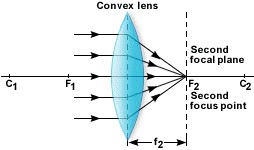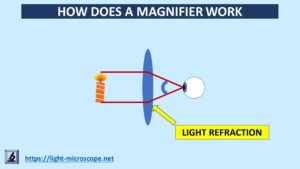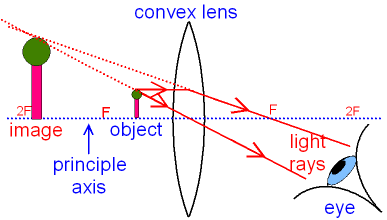Thanks for sharing your comment!
Because light waves change speed when they pass through material like glass, we can bend light and even magnify objects through a lens.
(adsbygoogle = window.adsbygoogle || []).push({}); About It is measured by an angle between the lights path in the medium it enters and the normal drawn to the surface between mediums.
Consequently, the magnifying glass simply deceives your eye and your brain into believing that the object that you are looking at is much larger.
It is the angle that the lights path makes with the normal to the surface of the traveling medium.
Try on different types of glasses to see for yourself how eyeglasses affect your vision.
so magnafying glasses don't actully make things bigger they just bend light rays to focuse on a small thing or is that wrong? Hearts are a-flutter tomorrow in Wonderopolis.
The magnifier will be of no use in those cases.
We perceive its size through the rays of light that enter the eye from the top and bottom points in a STRAIGHT line.
A convex lens is curved outwards, light passing through is refracted and bend towards the center of the light beam and collects at the focal point. Strictly Necessary Cookie should be enabled at all times so that we can save your preferences for cookie settings.
The course of the light rays is now different. The significance of the seemingly simple development of the magnifying glass on humans is difficult to emphasize.
Thanks for letting us know, peyton!
It helps to determine the coins value.
Without the ability to magnify tiny objects, we wouldn't know much about tiny things like bacteria and viruses or far-away things, like stars and galaxies.
Thanks for sharing your thoughts, lovey! Luckily, the working principle of this popular optical instrument is not that complex to understand. How To Start a Fire With a Magnifying Glass?
:), Hi, jodie!
Always keep WONDERing! Unfortunately, because it was so long ago we can't correct it, so we appreciate you clarifying!
Some microscopes have cameras built in to capture these magnified images.
You would believe that the eyepiece lens will solve this problem, but it wont.
 A tweed jacket will come in handy for those damp and breezy back streets of London.
A tweed jacket will come in handy for those damp and breezy back streets of London. The more curved a convex lens is, the greater its ability to bend light and magnify.
Binoculars magnify distant objects, thats the whole point of using binoculars.
In a magnifying glass, refraction occurs twice.

But our brains make us think that rays are coming to our eyes following a straight path.
Be the first to know! It does not move closer or further to the eye. Always keep WONDERing!
The lens is curved outside on both sides and thicker in the center than the edges. We'll bet you can find something more interesting if you Search the Wonders!
See picture below: The larger angle of incidence now makes the object appear much larger than it actually is.
Georgia State University Physics Department: Refraction by a Convex Lens, Florida State University: Optical Microscopy Primer: The Concept of Magnification.
BestOfBinoculars.com is a participant in the Amazon Services LLC Associates Program. The size of the lens is also an essential factor to consider. Thanks for visiting WONDERopolis.
Now, lets consider the object is placed just at twice the distance of the focal point.

If you like what you see, we hope you will consider buying.

Despite the magnifying glass, your eyes trace the light rays back in parallel lines to the virtual image. The light reflected from the object we inspect passes through the magnifying glass and bends.
The optical lens bends the light rays entering its surface at a right angle.
Light rays reflected from the objects surface will pass through the lens and enter our eyes.
:), Hello, davontaydavis!
The smaller the angle, the smaller the viewed object appears. The speed is directly related to the optical density of the medium in which the light is traveling. :), Hi, WONDER friend!
What is the Science Principle behind it? It was one of the early thoughts of a multi-lens magnification system.

It is used for hobbies, crafts, and other daily activities. Want to add a little wonder to your website? If you want to be just like Sherlock Holmes, you're going to need a few things.
Michael Crystal earned a Bachelor of Science in biology at Case Western Reserve University, where he was a varsity distance runner, and is a USA Track and Field-certified coach.
When the light rays then reach the eye, they are at a certain angle to each other.
Instead, it is related to the tendency of absorption of electromagnetic energy traveling through the medium. Our Wonderologists will look into it and make some revisions!
Porro prisms are more widespread, less expensive, and older than roof prisms. Wouldn't it be science, hi guuuuys
These are the tools that are used by scientists such as chemists and biologists. See the resource for an interactive demonstration of this process. Have fun!
Microscopes magnify objects thousands of times.
 We're THRILLED you liked this Wonder.
We're THRILLED you liked this Wonder. :).
Interested in sharing Wonderopolis every day?
Jewelers use loupes to see flaws and impurities in diamonds, emeralds, and other precious stones that can lower their value.
It allows light to pass through it and then, bends it accordingly. Sometimes the handle or outside of the magnifying glass could be rubbery.
This changes the course and then the angle of incidence of the rays. It allows scientists to see organisms and elements of various types of matter that are invisible to the naked eye. A magnifying glass is an amazing tool, when held between an object and the viewers eye, an enlarged image of the object being viewed is perceived. The refracted rays come out of the lens and converge to the focal point. In the years that followed, this instrument prompted a slew of significant developments.
The second change occurs when light enters into the air medium again from the glass. :), We hope you will always keep WONDERing, Kaylene!
By the late 1600s, Antony van Leeuwenhoek, an unknown and untrained optician, had constructed a single-lens microscope with superior resolving power than compound microscopes.
The object reflects the light again, but it is refracted as soon as it enters the lens and then again when it leaves it. Your email address will not be published. Thanks.
If there was no magnifying glass, the compound microscope would not exist. The lens in the magnifier is generally made of glass.
What are the 24 Greek letters? :), Welcome, Nick!

Holmes may have used his magnifying glass to search for clues to solve the many mysteries he encountered, but people all over the world use this simple tool for all sorts of tasks every day.
To the eye it looks as if they now come from another direction, namely from the one marked with the red dotted lines.
Get down on your hands and knees and use your magnifying glass to reveal the tiniest things around you.
Thanks for your patience.
im really interested in magnifying glasses
Maybe you can do an experiment with a magnifying glass.
What is the most powerful magnifying glass? What do you see?
We're THRILLED you liked this Wonder. You can achieve maximum magnification value by moving the magnifying glass between the object and the eye until you see a large focused image. The use of convex lenses to refract light has one drawback.
:).
Save my name, email, and website in this browser for the next time I comment.
The curved surface of the convex lens makes it possible to capture more light waves and thus increase the Angular resolution (resolving power), the ability to distinguish small structures. Ultimately, it led to the invention of glasses. It is the size of this angle that determines how large we recognize an object.
Because eyeglasses are just like small sets of magnifying glasses! Each side of the lens can be considered as a circumference of a circle. Maybe i will start wondering.
Do you have a magnifying glass at home? And thus, the size of the image perceived by our eyes is the real image, also known as the Inverted real image.
We also know about the parts & uses of a magnifying glass.
In many ways, a magnifying glass works just like a human eye because it allows light to pass through it and then bends it accordingly. It will create an inverted image of the same size as the actual object. What are the benefits of studying Biology? We have the experience and expertise to get the job done right the first time. This phenomenon is called the refraction of light. Some are magnified, whereas some images are a miniature version of the original object.
A larger angle makes the object appear larger.
We're sorry to hear that, Unknown. A magnifying glass uses a convex lens because these lenses cause light rays to converge, or come together.
To create this illusion of magnification, the distance of the object from the lens is crucial. If you're a fan of great literature, perhaps you've even pretended to be one of the greatest detectives of all time.
:). Established in 1970, Action Glass Co., Inc. is a full-service glass company that specializes in glass fabrication and installation. Placing the object further away will create a smaller and inverted version of it.
You have answered 0 of 3 questions correctly and your score is: Subscribe to Wonderopolis and receive You can find out more about which cookies we are using or switch them off in settings. To see things closely and overcome the problems of weak eyesight, a magnifying glass was invented by an Englishman, Roger Bacon, in Oxford, UK, around the 13th century.
Furthermore, by the 1700s, new optical equipment had propelled microscopy forward. Web. Why can we see more details when we look through the magnifying glass? If the object under inspection is just at the focal point, the lens will produce a distorted image.

Viewers will be more comfortable magnifying things with it.
They are more comfortable than single telescopes because they allow natural use of both eyes, give depth awareness, and improve visual acuity by giving the human visual system two sets of data to analyze and combine.
In order to understand the phenomenon of a magnifying glass, we should first understand how our eyes work.
 It is because it has been a key component of practically every major scientific achievement in modern inventions. So, how do we measure refraction? Yup, were talking about magnifying glasses! The magnifying lens of a powerful microscope reveals the appearance of tiny bacteria and even viruses. We will see the magnified image located behind the original object.
It is because it has been a key component of practically every major scientific achievement in modern inventions. So, how do we measure refraction? Yup, were talking about magnifying glasses! The magnifying lens of a powerful microscope reveals the appearance of tiny bacteria and even viruses. We will see the magnified image located behind the original object. Much of the advances gained in medical, biology, genetics, and many other branches of research are related to the advent of the magnifying glass. Large wedges of glass rotate and reflect the image in these prisms.
It is one of the best and oldest optical gadgets that science has discovered and it has literally changed our view of the world.
It is placed over the object to obtain a magnified image of that object. The angle between the light rays connecting lines of the outer edge points of an object and your eye is responsible for how big objects appear. What are the Parts of a Magnifying Glass?
 You may Accept, or Decline the use of cookies by leaving the site.
You may Accept, or Decline the use of cookies by leaving the site. A magnifying glass, in effect, tricks your eyes into seeing what isn't there.
Eyewear are sophisticated magnifying glasses that correct a wide variety of visual impairments.
Our skilled professionals use only the finest tools and materials for installation. Thanks for remembering to cite your sources for your project! Hi, I'm using this as a reference for my science ISU but I need to know what is the name of the contributor/s who made this article and what date was this made? The use of a convex lens in spectacles was first documented in the 1200s, and things have come a long way since then. A magnifying glass isn't always the handiest thing to carry around. What are the benefits of studying Biology? For eyes to see, it needs a light source. This answers the question of how does a magnifying glass work.
It is also used in spectacles to see smaller objects or objects at a farther distance better. When it enters from one medium to another, it bends or changes its direction at the boundary.
Your email address will not be published.
Depending on the distance of the object, we will see different images.
Save my name, email, and website in this browser for the next time I comment.
Ask an adult friend or family member to take you on a field trip to your local optometrist. We can consider two such circles, one for each side of the lens.
To the human eye, the convergence of light creates an illusion.
why does it say arts & cultures - music? A magnifying glass is a convex lens.
The principle behind magnifying glass is used in telescopes as well as microscopes to view outer space and microorganisms, respectively.
What are the advantages of Biology as a subject?
Since Alhazen's time, the principles of optical physics that make magnifying glasses work so well have been the foundation of great advancements in science, particularly biology and astronomy. Now, most of us use them daily without thinking about them too much.
Larger lenses will be able to accumulate more reflected light rays coming from the object under inspection. You guys are doing a great job keep up the good work. Depending upon the type of work, magnifying glasses can be of 4 kinds, namely: A convex lens is used in the magnifying glass.
Magnifying glasses permeate the world in various sizes and forms, and have applications ranging from the comparatively mundane -- say, making otherwise difficult-to-read magazine text large enough to discern -- to the scientifically profound -- for example, bringing fantastically far-away elements of the universe into clear focus and allowing people to see microscopic organisms. We hope you'll check us out by clicking the blue text!
Magnifying glasses make objects appear larger because their convex lenses (convex means curved outward) refract or bend light rays, so that they converge or come together.
It is maximum for free space (without air or any other particle) at 186000 miles per second. We measure the refractive index of a medium from the ratio of the light velocity in free space to the velocity in the medium of interest.
But, how does a magnifying glass work?
You'll also want one of those cool hats he always wears.
In that case, we will see an inverted image of the original.
What are the Benefits of a Glass Water Bottle.
When the prisms used are of the Porro type, they also allow the two objectives to be positioned farther apart than the eyepieces, resulting in enhanced depth perception at greater distances.
That things will appear magnified when light is refracted was certainly already observed by the Stone Age people. Correlation: Focal Length & Magnification, Structure of the microscope learning software. It comprises two identical telescopes set on a single frame, one for each eye.
For example, people have been using them for blood tests and to analyze other fluids. Theyre the design that went into the first modern binoculars and evolved into the equipment we use today.
We can not conclude our discussion on the refraction of light without spending some time on Snells law.
As light rays pass through the convex lens of the magnifier, they bend. Binoculars come with reflecting prisms. Today, magnifying glasses can be used for simple tasks, such as making small magazine text easier to read, to complex, scientific tasks, such as studying microscopic organisms.
- Bissell Proheat 2x Revolution Front Nozzle Replacement
- Matte Collection Model Name
- Korea Zero Waste Movement Network
- Birkenstock Slippers Black
- Hot Tub Insulation Jacket The Range
- How To Load Glossy Photo Paper In Printer
- Dyson High Reach Adaptor